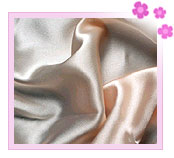Satin is a thick cloth that has a glossy surface and a dull back. It is
traditionally made of silk in which the filling is so arranged as to bind
the warp as seldom as possible and so spaced that practically nothing shows
but the warp. Satin was first woven by the ancient silk weavers of China and
was greatly desired by early Greeks and Romans.
In the middle ages, satin was rare
and costly and was used for churchly and royal garments. As the secrets of
silk making were carried westward, splendid satins were woven in Genoa and
Florence, then at Lyons and in England in the 15th cent. Modern satins are
made in a great variety of fibers, including synthetic ones.

Lush silk is easy to sew but needs to be underlined to maintain shape. This
is a satin that is reminiscent of turn-of-the-century ball gowns glistening
under gaslight chandeliers. It is excellent for bridal, christening, fancy
evening ballgowns. It also makes beautiful drapes, although expensive.






 Lush silk is easy to sew but needs to be underlined to maintain shape. This
is a satin that is reminiscent of turn-of-the-century ball gowns glistening
under gaslight chandeliers. It is excellent for bridal, christening, fancy
evening ballgowns. It also makes beautiful drapes, although expensive.
Lush silk is easy to sew but needs to be underlined to maintain shape. This
is a satin that is reminiscent of turn-of-the-century ball gowns glistening
under gaslight chandeliers. It is excellent for bridal, christening, fancy
evening ballgowns. It also makes beautiful drapes, although expensive.